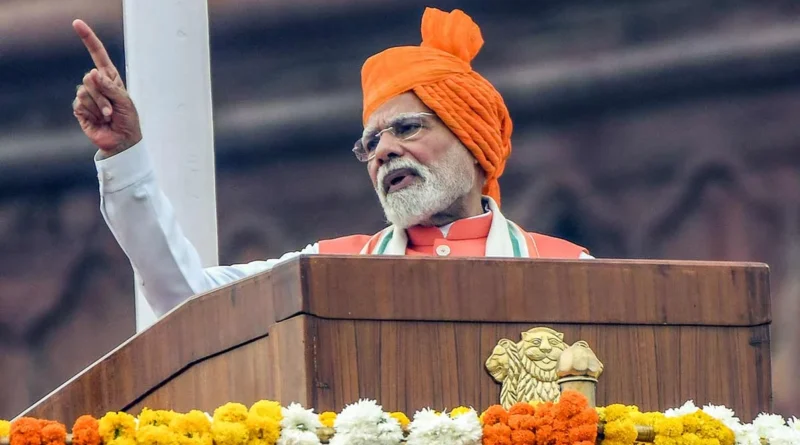Modi Believes in Big Moves: After Making Income up to ₹12 Lakh Tax-Free, Now Essential Goods Made Cheaper — Check the New GST Rate List
From daily essentials to healthcare, education, and industries, this decision will have a positive impact. Direct relief for consumers, encouragement for industries, and a boost to the market are its three major achievements.
Modi’s Big GST Reform: A Festival Gift for Citizens and a Boost for the Economy
Prime Minister Narendra Modi has once again demonstrated that his politics is not merely about holding power, but about ensuring the prosperity and convenience of citizens. While governments often resort to small measures to please the public, Modi’s approach is different—he prefers bold steps that deliver real relief. Earlier this year, the Union Budget gave taxpayers unprecedented relief by exempting income up to ₹12 lakh from tax, a move hailed as historic. That decision reflected the government’s priority of putting citizens first. Now, with a sweeping revision of GST rates, Modi has delivered a “bumper gift” to Indians a month before Diwali—one that few could have imagined.
The impact of the reform will be far-reaching—touching daily essentials, healthcare, education, and industries. The decision carries three major benefits: direct relief for consumers, encouragement for industries, and renewed momentum for the markets. This explains why households are celebrating, industry bodies have welcomed the move, and stock markets are responding positively. More than just an economic decision, it reflects Modi’s concern for citizens and his commitment to their prosperity. His approach shows that he uses opportunities not for political mileage alone, but to provide tangible relief to the people.
This step is expected to inject fresh energy into the Indian economy and fill the festive season with confidence and optimism. In effect, Modi has fulfilled the promise of a Diwali gift well before the festival itself. And this “Diwali gift” is not only financial relief but also a symbol of trust and assurance that the government stands firmly with its people.
Importantly, by fulfilling within 20 days his Independence Day pledge of a “simpler, lower tax system,” Modi also responded practically to U.S. President Donald Trump’s remark describing the Indian economy as “dead.” In truth, today’s India is proving its vitality and global importance.
A look at the decisions made during the 56th GST Council meeting shows that tax reform is not merely a matter of numbers but directly linked to people’s daily lives. From September 22, the changes will make many essential goods cheaper, while placing higher taxes on luxury and harmful products.
GST 2.0: What Gets Cheaper
Food and Essentials
- Dairy products: UHT milk is now tax-free (down from 5%), while condensed milk, butter, ghee, paneer, and cheese have been reduced from 12% to 5% or even zero.
- Staples & Packaged Foods: Malt, starch, pasta, cornflakes, biscuits, and even chocolates and cocoa products cut from 12–18% to 5%.
- Dry fruits: Almonds, pistachios, hazelnuts, cashews, and dates reduced from 12% to 5%.
- Sugar & Sweets: Refined sugar, syrups, toffees, and candies now in the 5% slab.
- Other foods: Edible oils, spreads, sausages, packaged meat and fish products, and malt-based foods moved to 5%.
- Snacks: Namkeen, mixtures, and roasted snacks now at 5% (down from 18%).
- Water: Natural/mineral water without sugar or flavor reduced from 18% to 5%.
Agriculture
- Fertilizers cut from 12–18% to 5%.
- Seeds and crop nutrients down to 5%.
Healthcare & Education
- Life-saving medicines and medical equipment: down to 5% or exempt.
- Educational goods and services (books, learning aids): now 0–5%.
Consumer Goods
- Electronics: Common appliances down from 28% to 18%.
- Footwear and textiles: cut from 12% to 5%.
- Paper industry: some categories reduced to zero.
- Cosmetics and personal care: Hair oil, shampoo, toothpaste reduced from 18% to 5%.
Automobiles
- Small cars: 28% → 18%.
- Motorcycles up to 350cc: 28% → 18%.
- Larger vehicles remain at 40% (no extra cess).
- All car parts at 18%.
- EVs unchanged at 5%.
Other Sectors
- Renewable energy equipment: 12% → 5%.
- Construction materials: cut to 5%.
- Sports goods, toys, leather, woodwork, handicrafts: now 5%.
Overall: Groceries, fertilizers, footwear, textiles, renewable energy, and many consumer goods see widespread relief, benefiting households, small businesses, and the middle class.
GST 2.0: What Gets Costlier
Sin and Luxury Goods
- Pan masala, gutkha, cigarettes, chewing tobacco, and bidis remain under high GST plus cess.
- Now taxed on retail selling price (RSP) instead of transaction value.
- Sugary/flavored aerated drinks: GST up from 28% to 40%.
- Luxury goods: Cigarettes, premium liquor, and high-end cars remain at 40%.
- Imported armored luxury sedans exempt only in rare cases (e.g., President’s office).
Energy & Fuel
- Coal: 5% → 18%, increasing costs for energy-intensive industries.
Services
- Restaurants inside “designated complexes” now taxed at 18% without ITC claims.
- Lotteries and intermediary services face revised valuation rules, keeping or raising tax burdens.
The Road Ahead
While the new GST rates bring significant relief to households and small businesses, higher taxes on coal and fuel remind us that India’s tax reform journey is still unfinished. The GST Council must ensure these changes evolve into a permanent, balanced system, not just short-term relief.
That said, the reforms are clearly boosting consumer confidence, strengthening investor sentiment, and energizing markets. With happy consumers, a positive industry response, and rising stock indices, one message is clear: India’s economy is ready to move ahead at an even faster pace.
Stay updated with Latest National News in Hindi on Prabhasakshi

